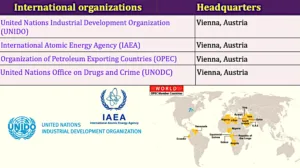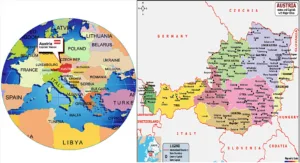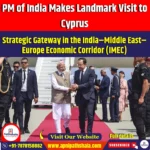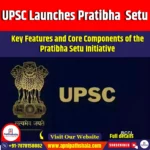PM Modi’s Austria visit ended on Wednesday (July 10). The successful trip saw the PM meet business leaders and discuss areas of bilateral cooperation, with this year marking 75 years of diplomatic relations between India and Austria.
Why PM Modi’s Austria Visit is in the News?
- The Indian Prime Minister made an official trip (July 10) to Austria, marking the first such visit in 41 years and celebrating the 75th anniversary of diplomatic relations between the two nations.
- The visit focused on strengthening bilateral ties by boosting cooperation in areas like technology, the economy, and global security.
- India’s relations with Austria were formally established in Given its support for non-alignment and Austria’s desire to sit out the Cold War between the Soviet Union and the United States, there were areas of mutual interest.
- PM Jawaharlal Nehru’s visit to Austria in 1955 was also the first-ever visit by a foreign leader to the newly independent nation.
India-Austria: Historical Background
- India and Austria share a historical connection that dates back to the 18th and 19th centuries, marked by significant contributions from Austrian scientists in India.
- One notable figure, Jesuit Father Josef Tieffenthaler, earned recognition as the Father of Modern Indian Geography.
- Besides his cartographic achievements, which included the first precise mapping of the middle Ganges River and its tributaries, he was also esteemed globally as a Sanskrit scholar and educator at the Jesuit College in Agra from 1740.
- In 1953, India supported Austria during negotiations with the Soviet Union for Austria’s State Treaty.
- Additionally, both nations shared common interests in the Non-Alignment Movement.
Political Relations
- High-Level Visits: There have been multiple significant visits between the two nations.
- Noteworthy examples include Austrian President Heinz Fischer’s trip to India in 2005 and Indian Vice President Hamid Ansari’s visit to Austria in These visits have bolstered political ties and bilateral cooperation.
- Bilateral Agreements: India and Austria have entered into numerous agreements aimed at enhancing cooperation in trade, science and technology, and cultural exchange.
- These agreements have paved the way for deeper bilateral relations and collaboration across various sectors.
India-Austria Economic Relations
- Trade between India and Austria has experienced steady growth over time.
- Key Indian exports to Austria include electronic goods, apparel, textiles, footwear, rubber articles, vehicles and railway parts, electrical machinery, and mechanical appliances.
- Austria exports machinery, mechanical appliances, railway parts, iron, and steel to India.
- Both countries have expressed interest in investing in each other’s markets. Austrian companies are active in India in sectors such as steel, construction, and automotive industries.
- Similarly, Indian companies have made investments in Austria, particularly in IT and software sectors.
- By the end of 2023, India’s direct investment in Austria stood at Rs 144 billion while Austrian direct investment in India reached about Rs 66 About 150 Austrian companies have branches in India.
What does Austria import from India?
- Electrical and electronic equipment worth $134 million, machinery, nuclear reactors and boilers worth $134 million, non-railway vehicles worth $130 million, footwear and related accessories worth $124 million, clothing worth more than $111 million, $95 million Made-to-order garments, organic chemicals worth $90 million, iron and steel worth $59 million, etc. were imported. Apart from this, the list of Austrian imports from India is quite long.
What does India import from Austria?
- The machinery is imported. In the same year, India imported from Austria iron and steel worth $36 million, electrical and electronic equipment worth $166 million, manmade staple fiber worth more than $103 million, optical, photo, technical and medical equipment worth more than $88 million, 65 million Dollar’s worth of organic chemicals and more than $53 million worth of plastic have been imported. The list of goods imported from Austria to India is even longer.
India-Austria Cultural Relations
- India and Austria have a rich history of cultural exchange dating back to the 16th century when Balthasar Springer journeyed from Tyrol to India with the third Portuguese fleet.
- The Austrian tradition of studying Indian culture, known as Indology, gained prominence between 1825 and 1920, marked by notable philologists and archaeologists.
- Sanskrit instruction at Vienna University began in 1845, culminating in the establishment of an independent Indology chair in
- Rabindranath Tagore, India’s philosopher-poet and Nobel Laureate, visited Vienna twice, in 1921 and 1926, fostering significant cultural and intellectual dialogue.
- His renowned 1921 lecture, ‘The Religion of the Forest,’ emphasized the importance of reconnecting with nature and cultivating unity and compassion.
- Cultural exchanges between the two nations continue through various initiatives, including Indian cultural festivals, art exhibitions, and classical music and dance performances in Austria, reciprocated by Austrian cultural events and musical showcases in India.
- Education and research collaborations are also robust, with several Austrian universities partnering with Indian counterparts to promote academic exchange and joint research projects.
Collaboration in science and technology
- In the realm of scientific and technological cooperation, India and Austria collaborate on diverse projects such as renewable energy, environmental technology, and space research.
- Both countries are eager to leverage Austria’s expertise in renewable energy and India’s strengths in information technology for joint innovation and technological advancements.
Vienna Convention on Diplomatic Relations
- This convention provides a framework for establishing, maintaining, and ending diplomatic relations between sovereign states. It also codifies diplomatic immunity, which gives diplomatic missions privileges that allow diplomats to perform their duties without fear of harassment or coercion from the host country.
- The convention is considered a cornerstone of international law and relations, and is almost universally ratified and observed.
Vienna Convention on Civil Liability for Nuclear Damage
- This convention was adopted in 1963 and went into effect in 1977 to harmonize national laws and provide financial protection against damage from certain peaceful uses of nuclear energy.
- The convention is based on principles such as equal treatment of victims and exclusive jurisdiction for the courts of the Contracting Party where the incident occurs.
Vienna Convention on the Law of Treaties
- This international agreement was drafted by the United Nations International Law Commission and adopted in 1969, going into effect in It governs written treaties between states and is divided into four parts: defining the agreement’s terms and scope, establishing rules for treaty adoption and conclusion, and addressing treaty interpretation and application.
- The convention’s principles include pacta sunt servanda, good faith, free will, equality, reciprocity, and lack of retroactivity.
Recent Developments (India & Austria)
- In 2024: The Prime Minister of India is currently visiting Austria, marking the first such visit by an Indian Prime Minister in 41 years since Indira Gandhi’s visit in
- Cooperation in the 2020s: India and Austria have been intensifying their partnership in recent years.
- Key areas of collaboration include combating climate change, strengthening trade relations, and promoting educational exchanges.
- Joint Ventures: Austrian companies are increasingly interested in forming partnerships and joint ventures with Indian counterparts, particularly in renewable energy and automotive components.
- Similarly, Indian firms are actively exploring opportunities in the Austrian market.
Highlights of the Prime Minister’s visit to Austria included:
- Indo-Pacific Stability: Both countries affirmed their dedication to a free and open Indo-Pacific, ensuring maritime security and upholding international laws such as UNCLOS.
- Political and Security Cooperation: Discussions encompassed developments in Europe and West Asia, with a mutual focus on peace restoration and adherence to international law, particularly concerning the Ukraine conflict.
- Economic Collaboration: Leaders agreed on advancing an economic partnership focusing on green and digital technologies, infrastructure, renewable energy, and smart cities.
- A bilateral Business Forum was initiated to foster partnerships and CEO-level interactions.
- Climate Commitments: Both nations pledged to collaborate on renewable energy, highlighting Austria’s Hydrogen Strategy and India’s Green Hydrogen Mission.
- They reaffirmed commitments under the UNFCCC, aiming to limit global temperature rise, and acknowledged respective targets for climate neutrality and emissions reduction.
- Technology and Innovation: Initiatives like the Start-Up Bridge and exchanges under Austria’s Global Incubator Network and India’s Start-Up India were emphasized for fostering innovation and leveraging digital technologies in Industry 0 and sustainable economy sectors.
- Cultural Exchanges: Efforts to promote cultural diplomacy, including yoga, Ayurveda, and other exchanges, were highlighted.
- Multilateral Cooperation: Both leaders reiterated support for multilateralism and backed comprehensive UN reforms. India supported Austria’s UNSC candidature for 2027-28, while Austria supported India’s for 2028-29.
- India also invited Austria to join the International Solar Alliance (ISA), emphasizing collaboration in renewable energy and sustainable development.
About Austria
- Austria is a landlocked country in Central Europe, known for its rich cultural history and stunning natural landscapes. Here are some key points:
- Capital and Major Cities: The capital is Vienna, a city famous for its musical heritage, classical architecture, and vibrant cultural scene. Other major cities include Salzburg, known as the birthplace of Mozart, and Innsbruck, known for its winter sports.
- Geography: Austria is characterized by its mountainous terrain, with the Alps covering much of the country. It also has picturesque lakes, valleys, and forests.
- History: Austria has a long history, having been part of the Holy Roman Empire, later the Austrian Empire, and then the Austro-Hungarian Empire until its dissolution after World War I. It became a republic in
- Economy: Austria has a well-developed social market economy and high standard of living. Key industries include machinery, chemicals, vehicle manufacturing, and tourism.
- Culture: Austria is renowned for its contributions to music, art, and literature. It has produced famous composers like Mozart, Haydn, and Schubert, and is home to historic institutions such as the Vienna State Opera and the Salzburg Festival.
- Language: The official language is German.
- Government: Austria is a federal parliamentary republic. The president is the head of state, while the chancellor is the head of government.
Explore our courses: https://apnipathshala.com/courses/
Explore Our test Series: https://tests.apnipathshala.com/









